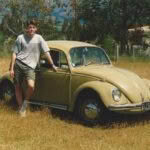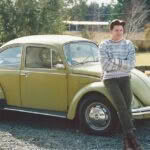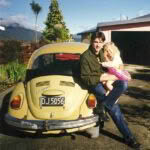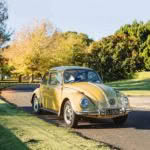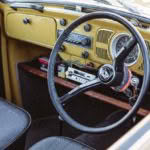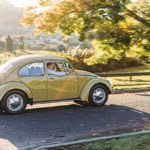A love story for the ages: A man, his long-lost car and his wife’s greatest Christmas present yet

Alan and the dub in 1991.
Don’t be fooled by the mild-mannered exterior of Alan Bekhuis’ Volkswagen Beetle. It’s been the subject of envy, love, loss, spying, wifely subterfuge and renewed devotion. It’s quite the brazen mistress.
Words: Claire Finlayson Photos: Anne Paar
When Alan Bekhuis was lured by his wife (two time Ockham Award-winning novelist Catherine Chidgey) to the neighbours’ place for drinks on Christmas Day 2012, he was oblivious to the epic car joy that lay in wait. Catherine had pulled off an inspired marital masterstroke: she’d secretly tracked down the 1970 Volkswagen Beetle Alan had reluctantly sold in 1998 and had it delivered to the neighbours’ garage. There were tears (Alan’s) and Christmas gift triumph (Catherine’s).
“I was dubbed (as it were) Best Wife Ever,” she says. “Not only by Alan but by many Facebook friends still coming to terms with their Christmas Day yoghurt makers and foot spas.”
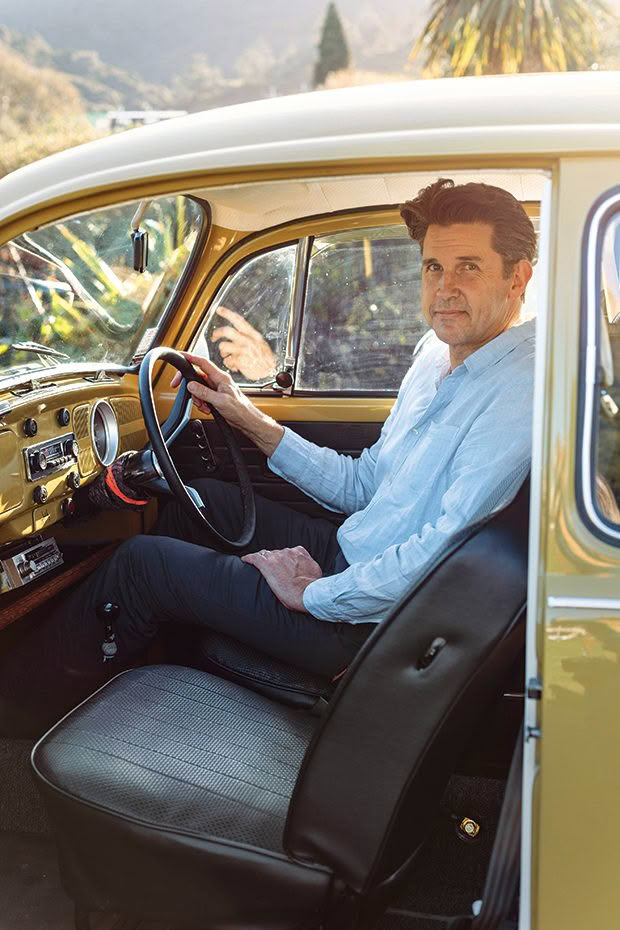
Since he had sold his beloved Beetle, Alan had been stalking it, like any proper dub obsessive would. Noting this, Catherine contacted the car’s new custodian, explained her husband’s monumental car regret, and asked if he wanted to sell. It turns out he did. “I arranged to have the car transported from Featherston to here in Ngāruawāhia,” says Catherine. “I remember nipping down to the BP for a furtive meeting with the driver to pay him cash so Alan wouldn’t see the charge on our bank statement — all very thrilling, like I was in an episode of Breaking Bad. At one point, the transport firm rang on the landline (instead of my mobile, as instructed) to ask about delivery — near disaster, as Alan answered.
But he failed to twig and thought it was a wrong number.”
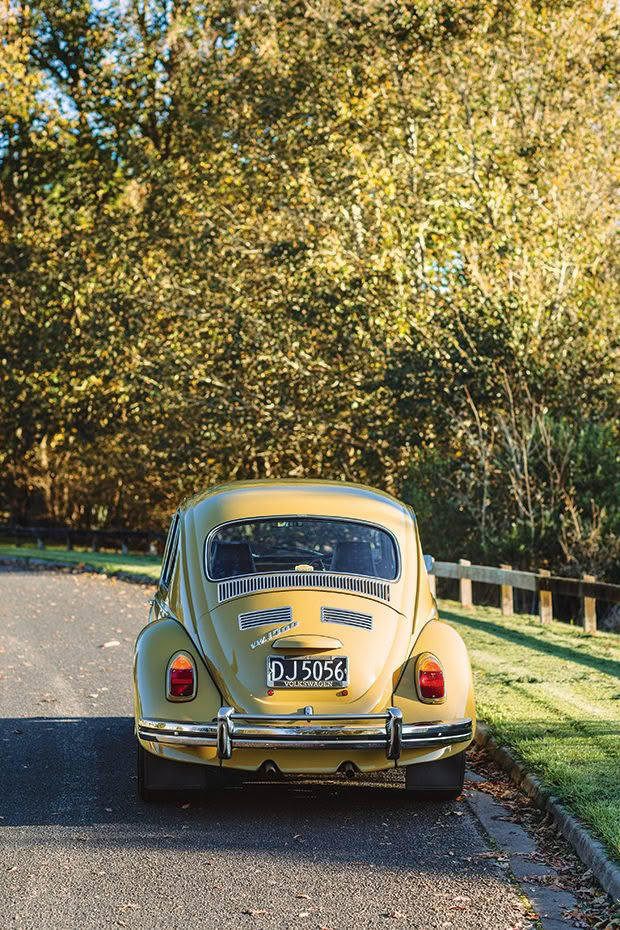
The car’s emotional freight dates back to 1984 when Alan’s older brother Ross arrived home in it from university. “To me, it had an air of sophistication: the smell of the upholstery, the ski company logo on the rear window, its Alpine car stereo — but most of all, the sense of independence it promised,” says Alan. At the time, he was 14 years old and very dependent.
Six years later, he bought the car — and all its inherent “cool” — from his brother. “It widened my sense of being an individual. It was quite life-altering. I was just in awe of it. It may as well have been gold-plated.”
- Alan and the dub in 1990.
- 1992.
- 1997.
Alan enjoyed eight dub years before selling it in 1998 to go overseas. That’s when the seller’s remorse began. He vowed he’d get it back one day. He even kept an automobile club sticker he came across while living in New York with the explicit intention of one day attaching it to the bumper of his lost dub.
The car waiting in the garage on Christmas Day was in a woeful, rust-pocked state. It had passed through the hands of three owners since Alan. But there were vestiges of the Bekhuis brothers’ era: stickers on the rear window, some receipts and change of ownership papers were in the same Unicef bag in the driver’s door pocket, the fizzy bottle top that Ross had repurposed as a brake fluid reservoir cap, a piece of garden hose Alan had installed to drain water from the air controller box.
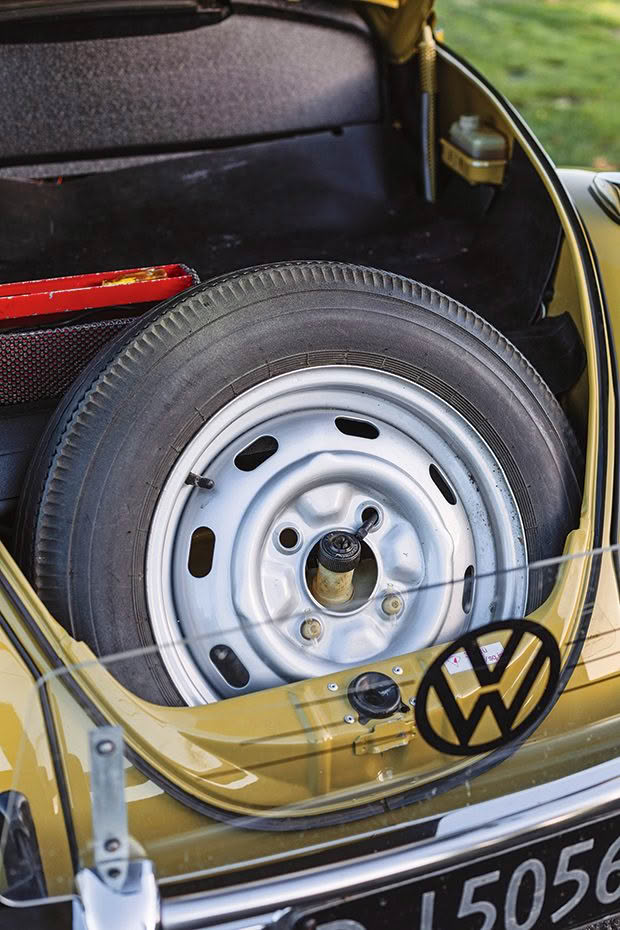
Keen to restore it to its original 1970 glory, Alan spent the next 11 years sprucing it up. He outsourced the bodywork and the paint job (it’s now returned to its former mustardy “pampas yellow“ glory) and did most of the interior himself. He found an unused AM radio made in 1970 for a Volkswagen Beetle, an Alpine stereo of the same model his brother had installed, and a set of Clarion speakers from 1985 on eBay. This precious time warp cargo was shipped in from the United States and France.
There’s a reason for this era-specific audio fidelity. “It means I can listen to the same cassettes I had in the 1990s, on the same stereo, playing through the same speakers. Reactivating memory is what this car is all about for me. I reflect on life a lot more when I drive the dub. Sometimes I get flashbacks of certain journeys and different people and remember what they were like. It’s a time machine to my 20s.”

One thing he couldn’t find was the car’s original engine (unbeknown to Alan, it was switched out during repairs in the 1990s and replaced with a freshly reconditioned one). “When I got the car back in 2012, I realised the numbers didn’t match, so I started searching for it. Whenever I see another Volkswagen, I always check the engine for the number. I’m still hunting for it.” (Volkswagen Beetle owners, if your engine bears the number H1258784, you know what you must do.)
Some people mistake Alan for a petrolhead. “I tell them I’m not a car person — I’m a that car person. I never wanted to get another Volkswagen — I only wanted that Volkswagen. When I get into modern cars, they seem hermetically sealed — like a sort of modern tomb. I don’t like the feel of them.” He’s thoroughly immune to the charms of his Subaru runabout and dismissive of Catherine’s “little tin can” Daihatsu.
The tin can owner realises she’s created a monster by bringing this dub back into the fold. “Alan is still obsessed with the thing. It’s the only car with a dedicated space in our crammed garage (mine is left to weather on the drive). Last Christmas, I had a T-shirt printed for him with the wiring diagram for his VW across his heart. It’s lovely to witness the bond between man and dub, even if it feels like I’ve inadvertently moved the mistress into the spare room.”
Asked how much he’s spent on restoring it, Alan says: “I couldn’t possibly tell you that — Catherine might find out. She calls it the money pit. We don’t talk about the Volkswagen a lot. She doesn’t dislike it, but it’s been quite an education for her on how much these car restoration projects involve.”
But given that she lovingly brought it back into his life, surely she can’t quibble about the upgrade costs? “It would be great if you could tell her that.”
Love this story? Subscribe now!
 This article first appeared in NZ Life & Leisure Magazine.
This article first appeared in NZ Life & Leisure Magazine.
